
11 minute read
Northern Lights: Martin
Northern lights
With a growing number of dedicated collectors, Northern art is in the spotlight. Cheshire specialist dealer and collector Martin Heaps reveals the names making waves
Northern art embraces the work of a multitude of 20th-century (and contemporary) artists who not only lived and worked in the North, but most importantly, took the landscape and culture of the region as their primary source of inspiration. From factories and coal mines, to rows of terraced houses, Northern artists brilliantly portrayed everyday life and elevated it into an artform.
OLD GUARD
You cannot speak of the genre without mentioning LS Lowry (1887-1976), as he is, without a doubt, the most famous of the bunch. Lowry developed a distinctive style of painting and is best known for his urban landscapes with human figures, often referred to as ‘matchstick men’.
He had an extraordinary ability to record seemingly mundane moments with his distinctive short-hand technique, describing a whole way of life with just a few
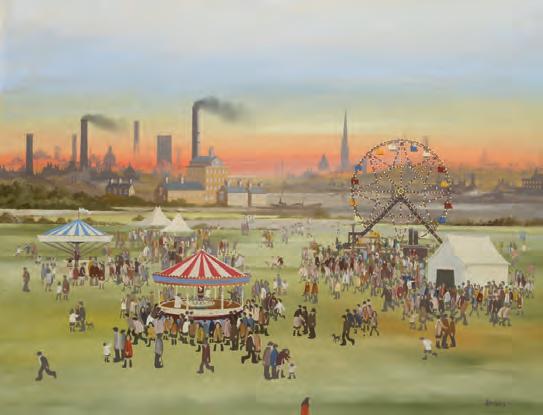
Above William Turner (1920-2013) Reopening of The Palace Theatre, 1981
Right Brian Shields (Braaq) (1951-1997) Fairground sold for £11,500 at the Leyburn auction house Tennants in March 2019, image courtesy of Tennants strokes of his brush or pen, finding his inspiration in the landscape of North Wales and Lancashire, and in the streets of Manchester and Salford.
EXPRESSIONIST INFLUENCE
William Ralph Turner (1920-2013) was the last of the great northern industrial painters who belonged to the Northern School of Artists influenced by LS Lowry.
In the ‘50s and ‘60s he was a regular visitor to the exhibitions held at the Crane Kalman Gallery in Manchester, where he was influenced by the works of the German Expressionists and the French Fauves, including Maurice de Vlaminck (1876–1958) and Georges Rouaul (1871-1958).
After being inspired by their work, he applied their colours and techniques to the industrial landscapes of the northwest of England.
Turner painted the North West and surrounding areas for about 60 years, often from memories and images obtained while indulging another of his passions – long-distance cycling. He was able to tell incredible stories through his art and his paintings are vibrant and vigorous, with a strong use of colour which lightens his often industrial subject matter.
BRAAQ TO THE FUTURE
Another pioneer of the northern art scene was Brian Shields (1951–1997) who is best known for painting industrial scenes of northern Britain. The unusual name of ‘Braaq’ is a misspelling of the famous French artist Braque which, on account of his artistic talent as a boy, was his nickname at school.
Braaq was born in Liverpool and was the fourth child in a family of 12, all of whom followed the arts. He launched into his professional career at the age of 23 following worldwide coverage of his anonymous murals. Having not been encouraged to become an artist, Shields became a trainee chef working at a drab hotel.
Looking to brighten up the hotel, Shields painted a mural, signing it Braaq to hide his identity. The identity of the mystery painter remained unknown for five weeks until Braaq was unmasked by a local journalist.
After that he was highly praised for his work following his first exhibition, and his paintings have since been shown worldwide in galleries from Canada to Holland, as well as London’s Royal Academy.
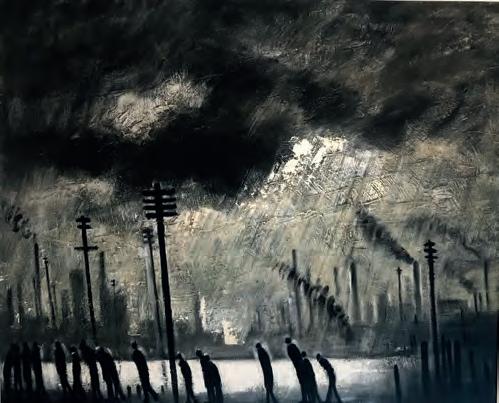
MAJOR TALENT
Wigan-born Theodore Major (1908-1999) is currently one of the most popular northern artists with his paintings in high demand. A new biography soon to be published by Michael Howard dubs Major, “Britain’s last forgotten 20th-century master”. The book will be sure to reignite interest in the artist who is slowly being discovered and admired for his vibrant flower pieces and powerful industrial scenes.
Poppies, an oil-on-board by Major sold for £7,100 at the Suffolk auction house Lacy Scott and Knight, while a similar work sold for £13,186 at Glasgow’s Great Western Auctions in September 2020. A decade earlier his work was achieving a third of that sum.
Major was a fervent Lancastrian who was against materialism, the commercial gallery system and the sale of his pictures to rich collectors.
His family has retained a good amount of his work which he painted for ordinary people, not money. He painted in a wide range of styles which he said was “to disturb and extend consciousness in the mind of the viewer.”
He was also president of the Wigan Art Club, which he founded in 1952. Major exhibited with the best, including LS Lowry at galleries including Tib Lane, Manchester, and Mercury Gallery in London. In 1948, his painting Kippers was included in the summer exhibition of the Redfern Gallery in London alongside works by Picasso and Henry Moore.
Left Theodore Major (1908-1999) Gathering at Wigan, image courtesy of Collect Art
Right Norman Cornish (1919-2014) St Charles’ Church, Tudhoe, oil on board, signed and dated ‘84, image courtesy of Anderson and Garland
Below right Edgar Rowley Smart (18871934) Summer Sunshine Giverny, image courtesy of Collect Art
MAKING AN IMPRESSION
Edgar Rowley Smart (1887-1934) is one of Manchester’s most notable impressionists and an artist to really take note of. Born 26 January, 1887, in Cheetham Hill, Smart studied at Manchester School of Art from 1901-1903, and in Liverpool from 1903-1906 under the etcher FV Burridge and then from 1906 to
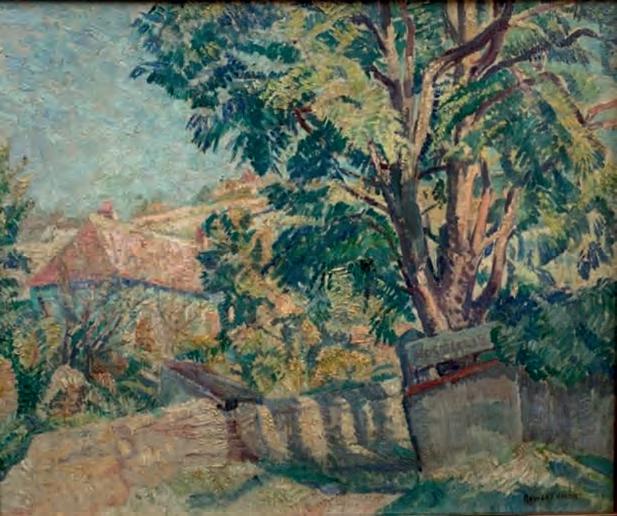
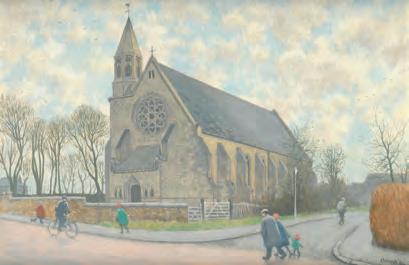
PITMAN PAINTERS
The Northern artists are not to be confused with the ‘Pitman’ painters, who were a group of miners turned artists whose work chronicled life in Ashington, Northumberland. The group was founded in the early 1930s as a Workers’ Educational Association class giving mining families access to the arts. One of the well-known pitman painters is Norman Cornish (1919-2014) who spent 33 years as a miner before turning to art. He was fascinated by the everyday, painting vivid views of ordinary life combining unpretentious realism with nostalgia.
1907, at the École des Beaux-Arts in Paris. He was a member of the Sandon Society, Liverpool, 1907, and founder of the Society of Modern Painters, Manchester, 1912.
His painting career was interrupted in 1914 by WWI where he served in France but was released from service due to tuberculosis, which continued to dog him for the rest of his life.
After his military service, Smart lived and studied with landscape and portrait painter, Augustus John (1878-1961) at his studio in Dorset. His work appears in a number of galleries, ranging from Manchester City Art Gallery to the Tate.

UNSUNG HERO
Harry Rutherford (1903-1985) has often been identified as one of the unsung heroes of the Lowry generation. In 1925, he was the first and youngest pupil to enrol in Walter Sickert’s new school of art in Manchester. Sickert had, in turn, trained under Edgar Degas. Rutherford’s association with Sickert was lifelong, with Sickert calling him his “ intellectual heir and successor”.
Rutherford was born in Denton in 1903, his father, William, was a gifted amateur artist who, with a group of friends, formed the Hyde Art Group. When he left school at 14, Rutherford was, unsurprisingly, encouraged to pursue art by his father.
He became the first visual artist to work in television presenting the BBC’s Cabaret Cartoons, where he drew variety artists as they performed.
While there are echoes of Lowry’s figurative depictions in Rutherford’s work, the influence of Sickert is also evident. In the late 1950s Rutherford was the resident of the Manchester Academy of Fine Arts and in his later years, taught at the Regional College of Art in Manchester, where his pupils included Geoffrey Key.
Left Harry Rutherford (1903-1985) Rural Scene of Mottram Village, oil on board, image courtesy of Collect Art
Lancashire hot shot
Helen Bradley (1900-1979) was born in a small village called Lees near Oldham in Lancashire. As a youngster she trained in jewellery and embroidery at the local school of art, but did not start to paint until the age of 65 as a means of telling her small granddaughter what life was like when she was a small girl.
Bradley’s paintings tend to feature the same recognisable characters, with her early works typically depicting Helen herself along with George, her younger brother, their mother, her three maiden aunts, the eligible bachelor, Mr Taylor, the bank manager and their family friend, Miss Carter – who always wore pink.
Many unusual interests are woven into her work, including a love of the Dutch masters and Chinese works of art, both reflected in her trademark recollection of atmospheres and events.
The last three years has seen a surge in demand for paintings by Helen Bradley with a world record price of £144,000 being achieved at auction in 2010.
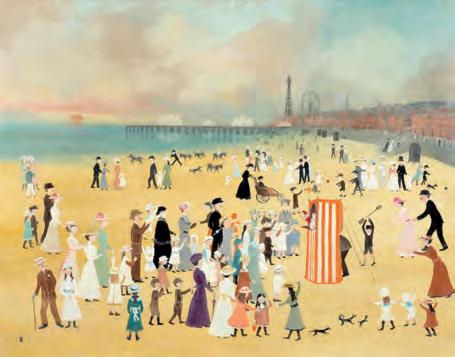

Right Geoffrey Key (b. 1941) Path between Trees, signed, oil on canvas, has an estimate of £4,000-£6,000 at Wilson55’s Northern art sale on September 23
Left Helen Bradley (1900-1979) Blackpool Beach, sold for £144,000 image courtesy of Bonhams
UNDER-THE-RADAR
One of the most under-the-radar names of the northern artists is Geoffrey Key (b. 1941). His acclaimed career as an artist spans five decades thus far, and he has just recently celebrated his 80th birthday.
His work is meeting growing acclaim, with his painting, Summer Meeting, selling for £9,516, at Wilson55’s auction in February 2021.
In 1958, Key attended the Regional College of Art where he studied under distinguished painters, draughtsmen and sculptors, most notably Harry Rutherford. He built on his early talent to achieve an international status and reputation for his individual and diligent expression of form, light and colour.
Key’s work features in private, public and corporate collections worldwide; in recent times one-man shows have taken place across the UK, Europe, Asia, Australia and the USA. His work has also been the subject of a number of published books and articles.


SELF TAUGHT
Alan Lowndes (1921-1978), is another under-the-radar, brilliant Northern artist. He was born in Stockport, the fifth child of a railway clerk. After leaving school at 14 he became a decorator’s apprentice.
In WWII he served in the Middle East, Italy and Austria. After the war he studied painting at night school, but otherwise, remained self-taught. He rose to prominence in the late ‘50s and early ‘60s, at the time when northern writers such as Stan Barstow, John Braine and Alan Sillitoe were coming to the fore. Any would-be collector of his work is advised to take a look at John Willett’s book Alan Lowndes: Paintings 1948-1972.
Above left Geoffrey Key (b. 1941) Summer Meeting, sold for £9,516 in February 2021, image courtesy of Wilson55
Above Peter Stanaway (b. 1943), Hartford Mill, Oldham, signed, oil on canvas, has an estimate of £500-£700 at Wilson55’s Northern art sale on September 23
Above right Trevor Grimshaw (1947-2001), Northern townscape, signed, has an estimate of £1,000-£1,500 at the same sale
Below left Alan Lowndes (1921-1978), Tight Rope Walker, image courtesy of Collect Art
Martin Heaps is the founder and owner of Collect Art a gallery based in Lymm, Cheshire, which specialises in northern art and has a number of works by the artists mentioned. For more details go to www.collectart.co.uk
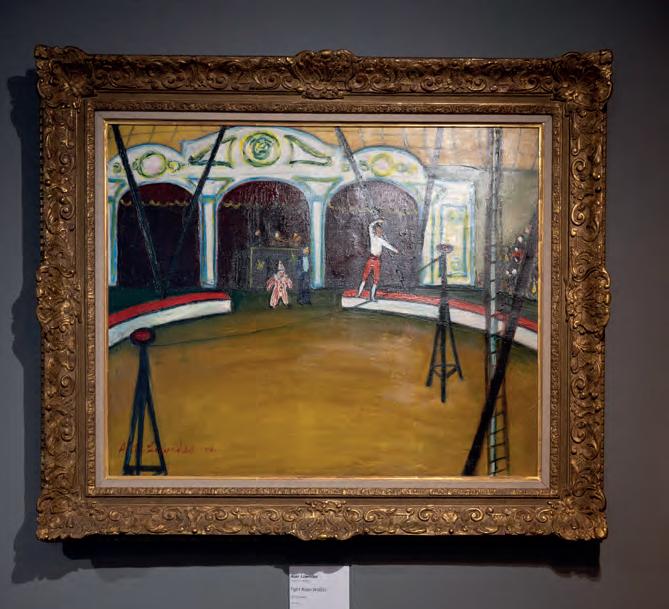
Collecting Northern art
We asked Stephen Sparron, Northern art specialist at the Nantwich auction house Wilson55, for his collecting tips

Northern art is a fascinating and fast-evolving area for collectors. Tracing its origins back to its founding father and major influence, LS Lowry – the first Northern artist to achieve commercial success during his lifetime – he paved the way for many others.
As well as the artists mentioned, other notables include Lowry’s tutor the French impressionist Pierre Adolphe Valette (1876-1942) who also depicted urban landscapes of the North, the Potteries artist Arthur Berry (1925-1994) and Trevor Grimshaw (1947-2001) whose monochrome work reflected industrial gloom.
These artists and their works continue to go from strength to strength in the saleroom and will always form the basis of a Northern art collection.
New generation
But there is a new generation of artists emerging. While paying homage to earlier masters, they are adding their own distinct imagery and interpretations and, in so doing, attracting a new generation of collectors.
Just as the previous generation of collectors remembered the smoky, urban cityscapes as a part of their upbringing, newer artists are painting townscapes of demolition and regeneration, as well as celebrating the beauty of the moorlands and coastline.
Previous pastiche imitations of Lowry’s northern scenes are now giving way to the new and evolving landscapes and views of the North.
Collectors have favourite artists, or even works from certain areas or periods. For example, some buyers prefer the early work of Geoffrey Key (b. 1941) with its muted palette, while others opt for later rural landscapes or still lives, or even his depiction of horses.
Northern art continues to go from strength to strength in the saleroom and, with its diversity of imagery, the collector is sure to find something which appeals to every taste.
Wilson55 holds four specialist Northern art sales a year, the next of which is on September 23, for more details go to www.wilson55.com










